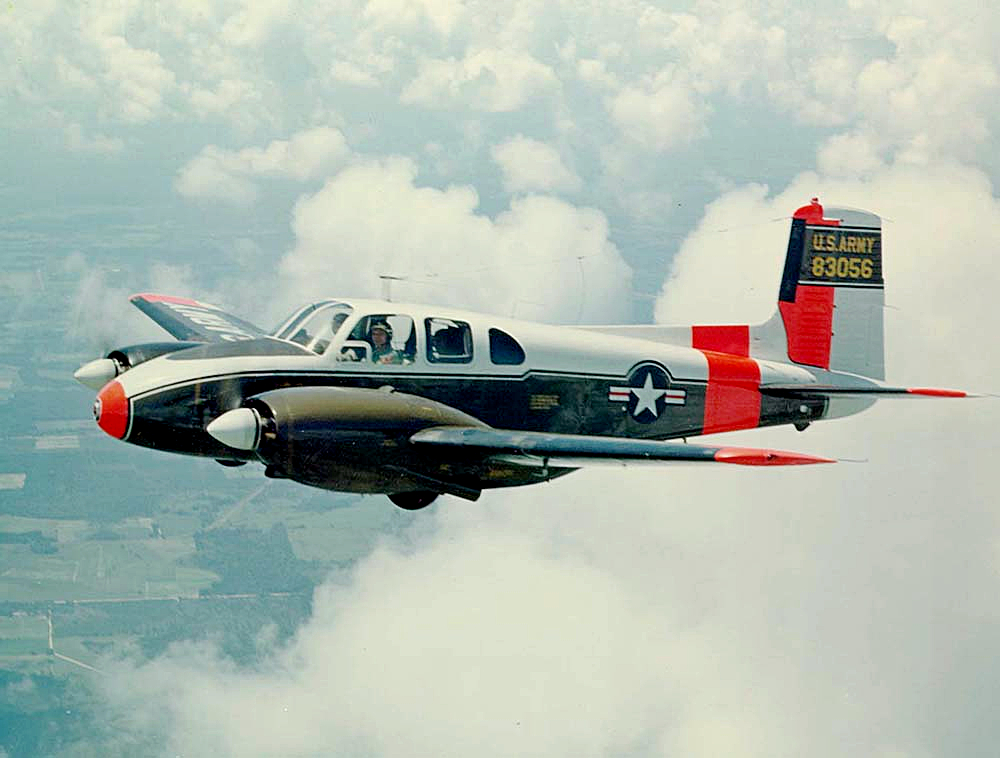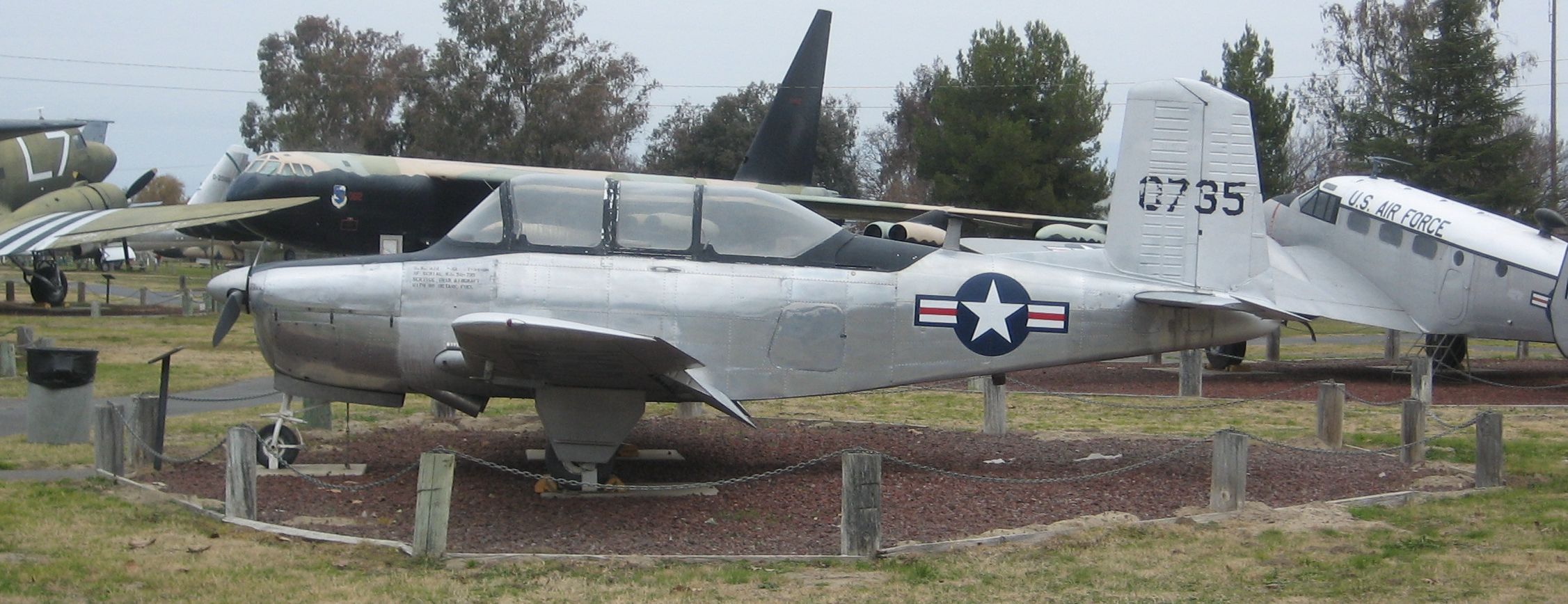|
Beech Duke
The Beechcraft 60 Duke is an American-built twin-engine, piston-driven fixed-wing aircraft designed and produced by Beechcraft. The aircraft has retractable tricycle landing gear and a pressurized cabin. The engines are turbocharged, which also pressurize the cabin with bleed air. Design Development of the Beechcraft 60 began in early 1965, which was designed to fill the gap between the Beechcraft Baron and the Beechcraft Queen Air. On December 29, 1966, the prototype made its first flight. On February 1, 1968, the FAA issued the type certificate.Taylor 1976, p.216. Distribution to customers began in July 1968. The passenger cabin is fitted with club seating and entry is by means of a port-side airstair entry door in the rear fuselage. The Beechcraft A60, which came onto the market in 1970, represented an advancement over the Baron, with an improved pressurized cabin utilizing advanced bonded honeycomb construction, lighter and more efficient turbochargers, and improved ele ... [...More Info...] [...Related Items...] OR: [Wikipedia] [Google] [Baidu] |
Light Aircraft
A light aircraft is an aircraft that has a Maximum Takeoff Weight, maximum gross takeoff weight of or less.Crane, Dale: ''Dictionary of Aeronautical Terms, third edition'', page 308. Aviation Supplies & Academics, 1997. Light aircraft are used as utility aircraft commercially for small-scale passenger and cargo aircraft, freight transport; for sightseeing, photography, cropdusting, and other so-called aerial work roles of civil aviation; for the personal-use aspect of general aviation; and in certain aspects of military aviation. Examples of aircraft that are at the maximum gross takeoff weight for this category include the de Havilland Canada DHC-6 Twin Otter and Beechcraft Super King Air, Beechcraft B200 Super King Air. Uses Uses include aerial surveying, such as monitoring pipelines, light cargo operations, such as regional airline, "feeding" cargo hubs, and passenger operations. Light aircraft are used for marketing purposes, such as banner towing and skywriting, and flig ... [...More Info...] [...Related Items...] OR: [Wikipedia] [Google] [Baidu] |
Spokane, Washington
Spokane ( ) is the most populous city in eastern Washington and the county seat of Spokane County, Washington, United States. It lies along the Spokane River, adjacent to the Selkirk Mountains, and west of the Rocky Mountain foothills, south of the Canada–United States border, Canadian border, west of the Washington–Idaho border, and east of Seattle, along Interstate 90 in Washington, Interstate 90. Spokane is the economic and cultural center of the Spokane metropolitan area, the Spokane–Coeur d'Alene combined statistical area, and the Inland Northwest. It is known as the birthplace of Father's Day (United States), Father's Day, and locally by the nickname of "Lilac City". Officially, Spokane goes by the nickname of ''Hooptown USA'', due to Spokane's annual hosting of the Spokane Hoopfest, the world's largest basketball tournament. The city and the wider Inland Northwest area are served by Spokane International Airport, west of Downtown Spokane, which is located near a ... [...More Info...] [...Related Items...] OR: [Wikipedia] [Google] [Baidu] |
John W
John is a common English name and surname: * John (given name) * John (surname) John may also refer to: New Testament Works * Gospel of John, a title often shortened to John * First Epistle of John, often shortened to 1 John * Second Epistle of John, often shortened to 2 John * Third Epistle of John, often shortened to 3 John People * John the Baptist (died ), regarded as a prophet and the forerunner of Jesus Christ * John the Apostle (died ), one of the twelve apostles of Jesus Christ * John the Evangelist, assigned author of the Fourth Gospel, once identified with the Apostle * John of Patmos, also known as John the Divine or John the Revelator, the author of the Book of Revelation, once identified with the Apostle * John the Presbyter, a figure either identified with or distinguished from the Apostle, the Evangelist and John of Patmos Other people with the given name Religious figures * John, father of Andrew the Apostle and Saint Peter * Pope John (disambigu ... [...More Info...] [...Related Items...] OR: [Wikipedia] [Google] [Baidu] |
Air Enthusiast
''Air Enthusiast'' was a British, bi-monthly, aviation magazine, published by the Key Publishing group. Initially begun in 1974 as ''Air Enthusiast Quarterly'', the magazine was conceived as a historical adjunct to ''Air International'' magazine. ''Air International'' was (and remains) involved with current aviation topics and the ''Quarterly'' concerned itself with historical matters. Each issue contained 80 pages; as a result certain articles were divided and each part appeared over a number of issues. ''Air Enthusiast'' was illustrated with colour and black-and-white photos, diagrams, profiles and three-view drawings. Earlier issues featured cutaway drawings, but these were dropped. The articles provided detail for varieties of aircraft and events. The magazine was published by three publishing companies and changed editors once, with William Green and Gordon Swanborough as joint editors for 16 years and Ken Ellis as the sole editor for the final 16 years. The magazine ... [...More Info...] [...Related Items...] OR: [Wikipedia] [Google] [Baidu] |
Beechcraft Twin Bonanza
The Beechcraft Model 50 Twin Bonanza is a small twin-engined aircraft designed by Beechcraft as an executive transport for the business market. It was developed to fill a gap in Beechcraft's product line between the single-engined Beechcraft Bonanza, Model 35 Bonanza and the larger Beechcraft Model 18, Model 18. The Twin Bonanza is dissimilar to the Bonanza, being much larger and heavier and using more powerful engines, while in its earliest form having only half the passenger capacity of the Model 18. Development The Twin Bonanza was first flown on November 15, 1949 after rapid development, begun only in April of that year. The aircraft was first designed to use Franklin Engine Company, Franklin engines with superchargers, but engine company owner Preston Tucker diverted all of its aviation resources to support his ill-fated Tucker 48 automobile project, and the aircraft was hastily modified to accept the Lycoming GO-435. However, the engine nacelles were not redesigned to fit ... [...More Info...] [...Related Items...] OR: [Wikipedia] [Google] [Baidu] |
Beechcraft T-34 Mentor
The Beechcraft T-34 Mentor is an American propeller-driven, single-engined, military trainer aircraft derived from the Beechcraft Bonanza, Beechcraft Model 35 Bonanza. The earlier versions of the T-34, dating from around the late 1940s to the 1950s, were piston engine, piston-engined. These were eventually succeeded by the upgraded T-34C Turbo-Mentor, powered by a turboprop engine. The T-34 remains in service more than seven decades after it was first designed. Design and development The T-34 was the brainchild of Walter Beech, who developed it as the Beechcraft Model 45 private venture at a time when there was no defense budget for a new trainer model. Beech hoped to sell it as an economical alternative to the North American T-6 Texan, North American T-6/SNJ Texan, then in use by all services of the U.S. military. Three initial design concepts were developed for the Model 45, including one with the Bonanza's signature V-tail, but the final design that emerged in 1948 incor ... [...More Info...] [...Related Items...] OR: [Wikipedia] [Google] [Baidu] |
Indicated Airspeed
Indicated airspeed (IAS) is the airspeed of an aircraft as measured by its pitot-static system and displayed by the airspeed indicator (ASI). This is the pilots' primary airspeed reference. This value is not corrected for installation error, instrument error, or the actual encountered air density, being instead calibrated to always reflect the adiabatic compressible flow of the International Standard Atmosphere at sea level. It uses the difference between total pressure and static pressure, provided by the system, to either mechanically or electronically measure dynamic pressure. The dynamic pressure includes terms for both density and airspeed. Since the airspeed indicator cannot know the density, it is by design calibrated to assume the sea level standard atmospheric density when calculating airspeed. Since the actual density will vary considerably from this assumed value as the aircraft changes altitude, IAS varies considerably from true airspeed (TAS), the relative ve ... [...More Info...] [...Related Items...] OR: [Wikipedia] [Google] [Baidu] |
Horizontally Opposed
A flat engine is a piston engine where the cylinders are located on either side of a central crankshaft. Flat engines are also known as horizontally opposed engines, however this is distinct from the less common opposed-piston engine design, whereby each cylinder has two pistons sharing a central combustion chamber. The most common configuration of flat engines is the boxer engine configuration, in which the pistons of each opposed pair of cylinders move inwards and outwards at the same time. The other configuration is effectively a V engine with a 180-degree angle between the cylinder banks: in this configuration each pair of cylinders shares a single crankpin, so that as one piston moves inward, the other moves outward. The first flat engine (Benz Contramotor) was built in 1897 by Karl Benz. Flat engines have been used in aviation, motorcycle and automobile applications. They are now less common in cars than straight engines (for engines with fewer than six cylinders) and ... [...More Info...] [...Related Items...] OR: [Wikipedia] [Google] [Baidu] |
Lycoming TIO-541
The Lycoming TIO-541 engine is a turbocharged, fuel-injected, horizontally opposed, six-cylinder aircraft engine featuring three cylinders per side, manufactured by Lycoming Engines. The TIO-541 family of engines includes the TIGO-541 turbocharged, fuel-injected, geared, horizontally opposed engine. There is no carburetted, non-turbocharged version of the engine, which would have been designated O-541 and therefore the base model is the TIO-541. Design and development The TIO-541 family of engines covers a range from to . The engine has a fuel injection system which meters fuel in proportion to the induction airflow. The engine has a displacement of 541.5 cubic inches (8.87 litres) and produces a maximum of in its TIGO-541 version. The cylinders have air-cooled heads. The first TIO-541-A1A was type certified on 23 February 1965 on the regulatory basis of CAR 13 effective 15 June 1956 as amended to 13-1 through 13-4. Variants ;TIO-541-A1A :Six-cylinder, turbocharged, fuel ... [...More Info...] [...Related Items...] OR: [Wikipedia] [Google] [Baidu] |
Beechcraft 60 Duke 3-view Line Drawing
Beechcraft is an American brand of civil aviation and military aircraft owned by Textron Aviation since 2014, headquartered in Wichita, Kansas. Originally, it was a brand of Beech Aircraft Corporation, an American manufacturer of general aviation, commercial, and military aircraft, ranging from light single-engined aircraft to twin-engined turboprop transports, business jets, and military trainers. Phillips, Edward H., aviation historian, BOOK:"Beechcraft: Pursuit of Perfection: A History of Beechcraft Airplanes,"1992, Flying Books, , 9780911139112, retrieved May 16, 2017Green, William, Gordon Swainborough, and John Mowinski, BOOK"Modern Commercial Aircraft,"1987, Portland House, New York, Beech later became a division of Raytheon and then Hawker Beechcraft before a bankruptcy sale turned its assets over to Textron (parent company of Beech's historical cross-town Wichita rival, Cessna Aircraft Company). It remains a brand of Textron Aviation.Ostrower, Jon and John Kell"Textron ... [...More Info...] [...Related Items...] OR: [Wikipedia] [Google] [Baidu] |
Jamaica Defence Force
The Jamaica Defence Force (JDF) is the combined military of Jamaica, consisting of an infantry Regiment and Reserve Corps, an Air Wing, a Coast Guard fleet and a supporting Engineering Unit. The JDF is based upon the British military model, with similar organisation, training, weapons and traditions. Once chosen, officer candidates are sent to one of several British or Canadian basic officer courses depending upon the arm of service. Enlisted soldiers are given basic training at JDF Training Depot Newcastle. As in the British model, NCOs are given several levels of professional training as they rise up the ranks. Additional military schools are available for speciality training in Canada, the United Kingdom, and the United States. History The JDF is directly descended from the West India Regiments formed during the period of British rule. The regiments were used extensively by the British to garrison the Colony of Jamaica and possessions in the West Indies. Other units in th ... [...More Info...] [...Related Items...] OR: [Wikipedia] [Google] [Baidu] |





